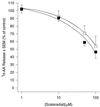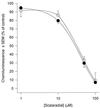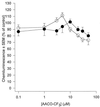Role of arachidonic acid and its metabolites in the priming of NADPH oxidase in human polymorphonuclear leukocytes by peritoneal dialysis effluent
- PMID: 9729536
- PMCID: PMC95640
- DOI: 10.1128/CDLI.5.5.683-689.1998
Role of arachidonic acid and its metabolites in the priming of NADPH oxidase in human polymorphonuclear leukocytes by peritoneal dialysis effluent
Abstract
Peritoneal dialysis effluent (PDE) contains a low-molecular-weight solute that will activate and prime the NADPH oxidase of human neutrophils via a phospholipase A2 (PLA2)-dependent mechanism. Since the products of PLA2 are known to activate and prime the oxidase we have investigated their role in the dialysis effluent-mediated activation and priming of human neutrophils. NADPH oxidase activity of PDE-primed and -unprimed neutrophils was measured by lucigenin-enhanced chemiluminescence in the presence of known inhibitors of the arachidonic acid cascade. Incubation of neutrophils with the nonselective PLA2 inhibitor quinacrine (0 to 100 microM) reduced oxidase activity in both primed and unprimed cells. Furthermore, primed cells were more sensitive to the action of quinacrine than were unprimed cells. We were unable to determine the relative roles of secretory PLA2 (sPLA2) and cytosolic PLA2 (cPLA2) since the selective sPLA2 inhibitor scalaradial (0 to 100 microM) inhibited oxidase activity in both groups of cells by similar degrees, while the specific cPLA2 inhibitor AACO-CF3 (0 to 50 microM) failed to affect activity in either group. Inhibition of platelet-activating factor (PAF), cycloxygenase, and 5-lipoxygenase-activating protein by hexanolamino-PAF (0 to 25 microM), flurbiprofen (0 to 25 microM), and MK886 (0 to 5 microM), respectively, had no effect upon oxidase activity. However, the direct inhibition of 5-lipoxygenase by caffeic acid or lipoxin A4 resulted in a similar concentration-dependent attenuation of oxidase activity in both primed and unprimed cells. Leukotriene B4 (LTB4) release from primed neutrophils was comparable to that from unprimed cells with the exception of phorbol myristate acetate-stimulated cells, which released fivefold more LTB4 than control. Taken together, these results suggest that it is arachidonic acid per se, and not its metabolites, that is important in priming of the neutrophil NADPH oxidase by dialysis effluent.
Figures







Similar articles
-
Phospholipases and the activation and priming of neutrophils by peritoneal dialysis effluent.Perit Dial Int. 1997 Sep-Oct;17(5):471-9. Perit Dial Int. 1997. PMID: 9358529
-
Effects of scalaradial, a type II phospholipase A2 inhibitor, on human neutrophil arachidonic acid mobilization and lipid mediator formation.J Pharmacol Exp Ther. 1994 Feb;268(2):709-17. J Pharmacol Exp Ther. 1994. PMID: 8113982
-
The regulation of neutrophil phospholipase A2 by granulocyte-macrophage colony-stimulating factor and its role in priming superoxide production.Br J Haematol. 1996 Mar;92(4):804-14. doi: 10.1046/j.1365-2141.1996.432970.x. Br J Haematol. 1996. PMID: 8616070
-
Adenosine. An endogenous inhibitor of arachidonic acid release and leukotriene biosynthesis in human neutrophils.Adv Exp Med Biol. 1999;447:107-15. Adv Exp Med Biol. 1999. PMID: 10086187 Review.
-
Bioactive lipoxygenase metabolites stimulation of NADPH oxidases and reactive oxygen species.Mol Cells. 2011 Jul;32(1):1-5. doi: 10.1007/s10059-011-1021-7. Epub 2011 Mar 18. Mol Cells. 2011. PMID: 21424583 Free PMC article. Review.
Cited by
-
Phospholipase A2 and its molecular mechanism after spinal cord injury.Mol Neurobiol. 2010 Jun;41(2-3):197-205. doi: 10.1007/s12035-010-8101-0. Epub 2010 Feb 3. Mol Neurobiol. 2010. PMID: 20127525 Free PMC article. Review.
-
Protective effect of quinacrine against glycerol-induced acute kidney injury in rats.BMC Nephrol. 2017 Jan 28;18(1):41. doi: 10.1186/s12882-017-0450-8. BMC Nephrol. 2017. PMID: 28129740 Free PMC article.
-
Cytosolic phospholipase A2-alpha is necessary for platelet-activating factor biosynthesis, efficient neutrophil-mediated bacterial killing, and the innate immune response to pulmonary infection: cPLA2-alpha does not regulate neutrophil NADPH oxidase activity.J Biol Chem. 2005 Mar 4;280(9):7519-29. doi: 10.1074/jbc.M407438200. Epub 2004 Oct 8. J Biol Chem. 2005. PMID: 15475363 Free PMC article.
-
NADPH oxidase-2: linking glucose, acidosis, and excitotoxicity in stroke.Antioxid Redox Signal. 2015 Jan 10;22(2):161-74. doi: 10.1089/ars.2013.5767. Antioxid Redox Signal. 2015. PMID: 24628477 Free PMC article.
-
Ceramide kinase regulates TNFα-stimulated NADPH oxidase activity and eicosanoid biosynthesis in neuroblastoma cells.Cell Signal. 2012 Jun;24(6):1126-33. doi: 10.1016/j.cellsig.2011.12.020. Epub 2011 Dec 30. Cell Signal. 2012. PMID: 22230689 Free PMC article.
References
-
- Bates E J, Harvey D P, Ferrante A. Inhibition of neutrophil respiratory burst and degranulation responses to platelet-activating factor by antagonists WEB 2086, CV 6209 and CV 3988. Int Arch Allergy Immunol. 1992;97:50–56. - PubMed
-
- Bauldry S A, McCall C E, Cousart S L, Bass D A. TNFα priming of PLA2 activation in human neutrophils—an alternative mechanism of priming. J Immunol. 1991;149:1277–1285. - PubMed
-
- Bauldry S A, Wykle R L, Bass D A. PLA2 activation in human neutrophils. J Biol Chem. 1988;263:16787–16795. - PubMed
-
- Boyum, A. 1968. Isolation of mononuclear cells and granulocytes from human blood. Scand. J. Clin. Lab. Investig. 21(Suppl. 97):77–89. - PubMed
-
- Classon H-E, Lundberg U, Malmsten C. Serum coated zymosan stimulates the synthesis of LTB4 in human PMN. Inhibition by cAMP. Biochem Biophys Res Commun. 1981;99:1230–1237. - PubMed
Publication types
MeSH terms
Substances
LinkOut - more resources
Full Text Sources

